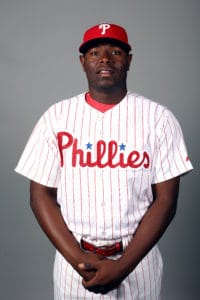

This week we’re diving in and profiling Phillies who made a leap forward in 2016. Today, we look at Hector Neris.
In a season of a surprising amount of surprisingly good things happening for the surprising Phillies, maybe the most impressive and unnoticed progress was the development of Hector Neris.
The tall, powerful right-hander had seen moderate success at the major league level in 2015 when he pitched the back-half of the year in Philadelphia. However, it followed the beginning of 2015 when he walked 24 in 37 innings in Lehigh Valley. With that kind of extreme split between the bad of triple-A and the good of the majors, there was also no reason to expect anything special from Neris in 2016.
But the big guy absolutely killed his first full major league season. From seemingly out of nowhere he became easily the most reliable bullpen arm on the team, probably the second-most reliable pitcher on the team (behind Jerad Eickhoff) and set himself up for a shot at becoming the team’s closer in 2017. The Phillies have brought in multiple closer candidates (Pat Neshek, Joaquin Benoit) and still have the 2016 closer (Jeanmar Gomez), so it’s an open competition. But Neris, on the strength of his 2016, has given the Phillies something to mull when it comes time to assign Opening Day bullpen roles.
Let’s start by saying we forgive him for September, though his 6.30 ERA from Sept. 6 to the end of the season probably ranked somewhere near the top for Phillies relievers for the month. We’ll just say the suckitude of the September bullpen was contagious, leave it at that and move on.
Forgetting September, Neris is the epitome of what this Phillies rebuild should look like: a little-known, homegrown product making peanuts and under team control for the foreseeable future who took it upon himself to get better. Never thought of as more than a middle-innings guy, Neris followed up a pretty decent 2015 by committing to a split-finger fastball before the 2016 season. He threw the pitch about 28 percent of the time in 2015, but in 2016, he threw it more than 52 percent of the time and increased its velocity by nearly 2 mph. The league hit just .138 against his split in 2016, according to Fangraphs.
That’s dramatic enough an increase in production level to go far beyond calling it a “fluke” year and instead likely should labeled as a change in pitching style that worked like gangbusters. If that production only happened in the first two months – like a lot of Phillies production in 2016 – before the team got through the league once, that’s one thing. But for Neris it happened for five solid months with successful appearances against teams he’d already faced multiple times. If you too are willing to forgive the gawd-awful September, Neris’ season ranked among the best set-up seasons in the National League.
At the same time, it’s legitimate to ask whether the Phillies should consider trading Neris. His value may never be higher, and of all the things the Phillies need right now, the furthest down the line is a lights-out, late-inning bullpen piece. It’s nice to have, but if the Phillies can turn Neris – or a package including Neris – into a valuable piece of the rebuild, should they do it? My answer on that question, no matter who the player is, is yes. There isn’t an untouchable person within this franchise that I wouldn’t part with in a heartbeat if I thought it would hasten the rebuild.
But like the situation with Ken Giles, there is no reason for the Phillies to jump at any offer on Neris. Apparently they haven’t, since he’s still on the team and almost definitely had interested parties knocking on the offseason door. The problem I’m sure the Phillies have in getting a satisfying return for him is that he doesn’t have enough built-up equity among league brass to command any kind of future cornerstone in return. Packaging Neris with some of the other young arms obviously would make the return price rise, but I’d like to think the Phillies already explored that avenue at the deadline, in the offseason, or both, and it didn’t work to their liking.
Even if they don’t trade him, he’ll be a very good piece to have on the team in 2017, a dependable bullpen arm making near the league minimum and allowing for miles of flexibility while he’s under team control through 2021 and not even eligible for arbitration until after the 2018 season. A year again like 2016 and he’ll put himself in the discussion to be a building block of the future, or some delicious trade bait that could bring in a more necessary potential building block.
If he implodes, he’s still the same thing – making the league minimum and under team control through 2021. No harm, no foul.